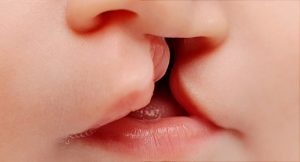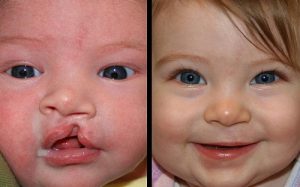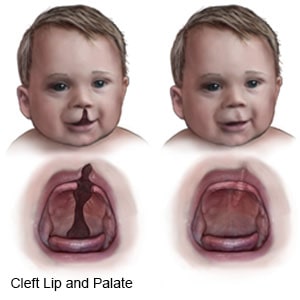Cleft lip
Cleft lip and cleft palate are openings or split in the upper lip, the roof of the mouth (palate) or both. Cleft lip and cleft palate result when facial structures that are developing in an unborn baby don’t close completely. Cleft lip is among the most common birth defects. The most commonly occur as isolated birth defects but are also associated with many inherited genetic conditions or syndromes. This is true that having a baby born with a cleft can be upsetting, but cleft lip can be corrected so no worries. In most babies, a series of surgeries can restore normal function and achieve a more normal appearance with minimal scarring.
Cleft Lip Causes
Cleft lip occurs when tissues in the baby’s face and mouth don’t fuse properly. Normally, the tissues that make up the lip and palate fuse together in the second and third months of pregnancy. But in babies with cleft lip and cleft palate, the fusion never takes place or occurs only partway, leaving an opening (cleft). Researchers believe that lots of cases of cleft lip and cleft palate are caused by an interaction of genetic and environmental factors. In many babies, a definite cause isn’t discovered. The mother or the father can pass on genes that cause clefting, either alone or as part of a genetic syndrome that includes a cleft lip or cleft palate as one of its signs. In some cases, babies inherit a gene that makes them more likely to develop a cleft, and then an environmental trigger actually causes the cleft to occur.
Cleft Lip Symptoms
Usually, a split (cleft) in the lip or palate is immediately identifiable at birth. Cleft lip may appear as:
- A split in the lip and roof of the mouth (palate) that affects one or both sides of the face.
- A split in the lip that appears as only a small notch in the lip or extends from the lip through the upper gum and palate into the bottom of the nose.
- A split in the roof of the mouth that doesn’t affect the appearance of the face.
Less commonly, a cleft occurs only in the muscles of the soft palate (submucous cleft palate), which are at the back of the mouth and covered by the mouth’s lining. This type of cleft often goes unnoticed at birth and may not be diagnosed until later when signs develop. Signs and symptoms of submucous cleft palate may consist:
- Difficulty with feedings
- Difficulty swallowing, with potential for liquids or foods to come out the nose
- Nasal speaking voice
- Chronic ear infections
Cleft Lip Complications
Children with cleft lip with or without cleft palate face a variety of challenges, according to the type and severity of the cleft.
- Difficulty feeding
One of the most immediate concerns after birth is feeding. While a lot of babies with cleft lip can breast-feed, a cleft palate may make sucking difficult.
- Ear infections and hearing loss
Babies with cleft palate are especially at risk of developing middle ear fluid and hearing loss.
- Dental problems
If the cleft extends through the upper gum, tooth development can be affected.
- Speech difficulties
The reason why is that, the palate is used in forming sounds, the development of normal speech may be affected by a cleft palate. Speech may sound too nasal.
- Challenges of coping with a medical condition
Babies with clefts may face social, emotional and behavioral problems due to differences in appearance and the stress of intensive medical care.
Cleft Lip Risk factors
Several factors may increase the likelihood of a baby developing a cleft lip consisting:
- Family history
Parents with a family history of cleft lip or cleft palate face a higher risk of having a baby with a cleft.
- Exposure to certain substances during pregnancy
A cleft lip can be more likely to occur in pregnant women who smoke cigarettes, drink alcohol or take certain medications.
- Having diabetes
There is some evidence that women diagnosed with diabetes before pregnancy may have an increased risk of having a baby with a cleft lip with or without a cleft palate.
- Being obese during pregnancy
There is some evidence that babies born to obese women may have an increased risk of cleft lip and palate.
Researches have shown that the males are more likely to have a cleft lip with or without cleft palate. Cleft palate without cleft lip is more common in females.
When Should Visit the Doctor?
Cleft lip repair and other surgeries to help kids born with a cleft lip have greatly improved recently. Lots of kids who undergo them have very good results. There are risks with any surgery, though, so call the doctor if your child:
- has a fever above 101.4˚F (38.5°C)
- has lasting pain or discomfort
- has heavy bleeding from the mouth
- can’t drink fluids
Cleft Lip Treatment
Fortunately, the surgery can close a cleft lip, enabling the child to speak and eat without difficulties. A range of interventions is available for children born with a cleft. An orthodontist may start to repair the palate and bring the lips together within a week of birth. This treatment, called nasoalveolar molding (NAM) 83 to prepare the infant for future surgery. Surgery to close the cleft lip may take place within 3 to 6 months of birth. An infant will generally receive treatment for a cleft palate between the ages of 9 and 18 months. This should enable the child to speak and eat without further difficulties. Corrective surgery may help realign the jaw. In cases where a child needs surgery to correct the jaw, some doctors would prefer to wait until the child reaches the ages of 10 to 12 years before performing the surgery. Waiting for all adult teeth to develop before the surgery may prevent the need for corrective surgeries further down the line. Other specialists prefer to correct the jaw earlier on, arguing that speech therapy is less effective when the patient is older. Most children with a cleft lip or palate will need a combination of surgical methods and operations as they grow. The cleft sometimes reaches the maxillary alveolar ridge, the edge along which the upper jaw meets the teeth. When this occurs, the surgeon takes bone tissue from another part of the body, such as the hip, and uses it to fill the cleft. In lots of countries, a cleft palate or craniofacial team monitors the infant until they reach adulthood. For some people, monitoring might continue for life. Scarring from modern cleft surgery is often minimal, but the individual may receive further surgery later in life to cosmetically correct remaining scar tissue.










Leave a Reply
Want to join the discussion?Feel free to contribute!